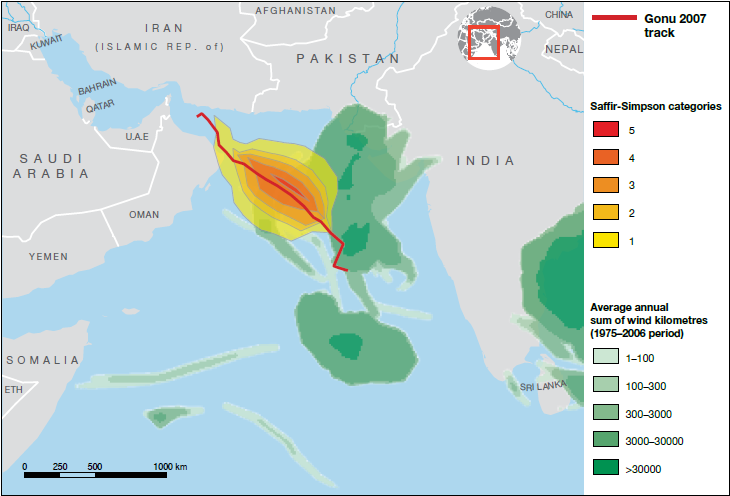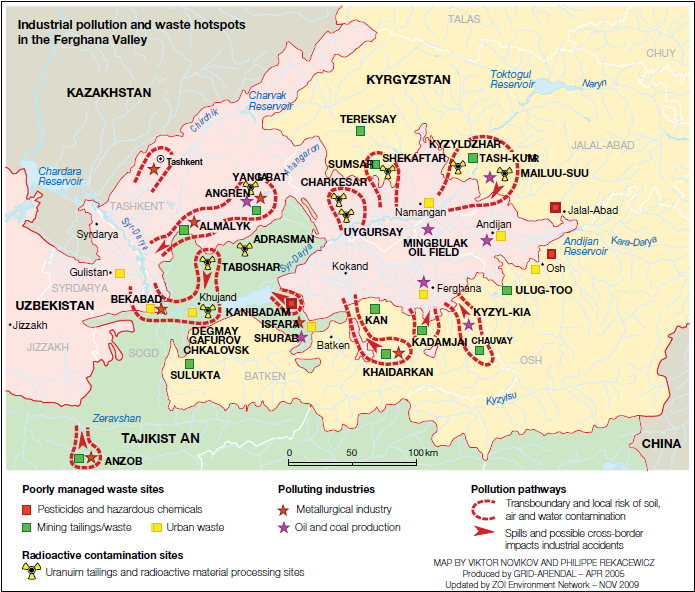 |
Global Assessment Report on Disaster Risk Reduction 2011
Revealing Risk, Redefining Development |


  |
2.5 Emerging risks
Countries are faced with a range of emerging risks associated with extremely low-probability hazards such as volcanic eruptions or extreme space weather, and new patterns of vulnerability associated with the growing complexity and interdependency of the technological systems on which modern societies depend, including: energy, telecommunications, finance and banking, transport, water and sanitation. These new vulnerabilities multiply disaster risks and can trigger cascading and concatenated system breakdowns at different scales which are difficult to model, but which can exponentially magnify impacts.
2.5.1 Volcanic eruptions affecting the global weather systemThe eruption of Huaytaputina in 1600 showed that the mid-latitudes of the northern hemisphere can experience slight winter warming and marked summer cooling due to the spread of volcanic ash and gas from the tropics by global air circulation patterns (Pyle, 1998Pyle, D.M. 1998. How did the summer go? Nature 393: 415–416. ). Of the more than 550 active volcanoes in the world, 154 erupted between 1990 and 1999 (Siebert and Simkin, 2011. Siebert, L. and Simkin, T. 2011. Volcanoes of the world: An illustrated catalog of holocene volcanoes and their eruptions. In: Smithsonian Institution, Global Volcanism Program Digital Information Series, GVP-3 [online database]. www.volcano.si.edu/world/. ), and the direct risks associated with these can be estimated. In Europe, for example, there is US$87 billion of exposed value at risk to the 10 volcanoes that potentially affect population centres of at least 10,000 inhabitants (Spence et al., 2009. Spence, R., Gunesekara, R. and Zuccaro, G. 2004. Insurance risks from volcanic eruptions in Europe. London, UK:Willis Research Network. ). Despite a 30 percent probability of an eruption occurring in the 21st century the size of that of Tambora (Indonesia) in 1815 (.  Sparks, 2010 Sparks, 2010 Sparks, S. 2010. Global volcanic risk. Background paper prepared for the 2011 Global Assessment Report on Disaster
Risk Reduction. Geneva, Switzerland: UNISDR. Sparks, S. 2010. Global volcanic risk. Background paper prepared for the 2011 Global Assessment Report on Disaster
Risk Reduction. Geneva, Switzerland: UNISDR.Click here to view this GAR paper. 2.5.2 Extreme space weatherGeomagnetic storms represent another low-probability, sequential risk whose impacts are difficult to measure. These storms are characterized by severe disturbances of the upper atmosphere and near-Earth space environment, caused by the magnetic activity of the sun. Such disturbances have always occurred but are a growing hazard for modern societies and the global economy, which are increasingly dependent on interconnected electric power grids and telecommunications and other systems affected by these disturbances. For example, Canada’s Hydro-Quebec power grid collapsed during a geomagnetic storm in March 1989, leaving millions of people without electricity for up to nine hours (National Research Council, 2008National Research Council. 2008. Severe space weather events: Understanding societal and economic impacts. Washington DC, USA: National Academies Press. ).. Although the probability of such blackouts is low, the potential for cascading impacts in vulnerable systems that depend on power grids is increasingly high, such as banking and finance, government services, transport and communications, and drinking water. The evolving connectedness and interdependency of these systems increases the probability of joint failures and means that the real risk is difficult to calculate and quantify, and is often underestimated. The 1859 Carrington super storm was the most spectacular geomagnetic storm in recent history but occurred in a world without interdependent networks and systems. If a similar storm were to occur today, the increased vulnerability could lead to unprecedented impacts. 2.5.3 Unexpected climate extremesTwo recent cyclones, a Category 2 storm that struck Santa Catarina province in Brazil in 2004 and Cyclone Gonu, which made landfall in Oman and the Persian Gulf in 2007, occurred in locations that had never in recorded history experienced storms of such magnitude (Figure 2.33). Contemporary populations have been unprepared for such extremes as the 2003 European heat wave or the 2010 Russian forest fires, which expose emerging or hidden vulnerabilities.Figure 2.33
The track of Cyclone Gonu (2007)  Global climate change may generate climate extremes for which there may be no historic precedent. Although it is still not possible to attribute the cause of individual events such as these to climate change, stochastic modelling can provide governments with insights into possible scenarios (ECA, 2009 ECA (Economics of Climate Adaptation). 2009. Shaping climate adaptation: A framework for decision-making. New York, USA: McKinsey & Company. ).Available at http://www.mckinsey.com/App_Media/Images/Page_Images/Offices/SocialSector/PDF/ECA_Shaping_Climate%20Resilent_Development.pdf. 2.5.4 Interactions between physical and technological hazardsOn 11 March 2011, Japan declared an ‘atomic power emergency’ when a devastating earthquake and tsunami damaged the Fukushima Daiichi Nuclear Power Station and caused a radioactive leak (Wald, 2011Wald, M.L. 2011. Japan declares emergency at nuclear plant. New York Times, 11 March 2011, sec 1. ). This
synchronous failure is posing major challenges
to Japan, but its impacts are already being felt
globally, in capital markets and in the nuclear
energy industry... Other such difficult-to-quantify risks are associated with major fires at industrial and petrochemical facilities. In addition to the effects of explosion and fire, such disasters may include the release of toxic gases. The red sludge from a burst bauxite storage reservoir in October 2010 near the Hungarian town of Ajka is one example of the consequences of poorly managed storage of highly toxic industrial and mining waste. Nine people were killed and more than 7,000 affected by the million cubic metres of spilled toxic sludge, and the full environmental and economic damage are not yet known (EM-DAT, 2011c EM-DAT. 2011c. Disaster country profile: Hungary. Brussels, Belgium: Université Catholique de Louvain, ).. Many similar chemical storage sites are also located in areas prone to other physical hazards. The remnants of the Soviet nuclear arms industry in Central Asia, for example, are located in an area prone to earthquakes, floods and landslides (Figure 2.34) (Sevcik, 2003 Sevcik, M. 2003. Uranium tailings in Kyrgyzstan: Catalyst for cooperation and confidence building? The Nonproliferation Review 10 (1): 147-154.. ;
Hobbs, 2010Hobbs, C. 2010. Current and future risks posed by unprotected radioactive waste sites in Central Asia. Background Paper prepared for the 2011 Global Assessment Report on Disaster
Risk Reduction.Geneva, Switzerland: UNISDR.. ). Kyrgyzstan and Tajikistan are both subject to earthquakes, landslides and flooding that could magnify an already high risk of contamination (Sevcik, 2003Sevcik, M. 2003. Uranium tailings in Kyrgyzstan: Catalyst for cooperation and confidence building? The Nonproliferation Review 10 (1): 147-154.. ; Hobbs, 2010Hobbs, C. 2010. Current and future risks posed by unprotected radioactive waste sites in Central Asia. Background Paper prepared for the 2011 Global Assessment Report on Disaster
Risk Reduction.Geneva, Switzerland: UNISDR.. ). The compound risks posed by the proximity of nuclear tailings to natural hazards in Central Asia are particularly severe, but they are not
unique. Mining and toxic-waste storage occurs in hazard-prone areas in many other countries, often without adequate risk identification or risk management. If such activities are initiated in countries with weak risk governance capacities, these compound risks will only increase.Figure 2.34
Industrial pollution and waste hotspots in the Ferghana Valley, an area prone to earthquakes, landslides and flooding 
|
  |
